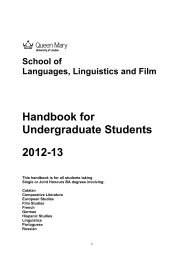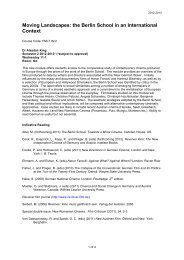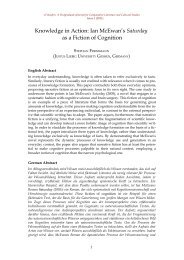Finnegans Wake - Queen Mary, University of London
Finnegans Wake - Queen Mary, University of London
Finnegans Wake - Queen Mary, University of London
You also want an ePaper? Increase the reach of your titles
YUMPU automatically turns print PDFs into web optimized ePapers that Google loves.
eTransfers. A Postgraduate eJournal for Comparative Literature and Cultural Studies<br />
Issue 1 (2011)<br />
subject has here fallen into language, where it evades attempts at theoretical<br />
classification. As critic Jean-Michel Rabaté notes,<br />
[w]e generally agree that any theory, while covering a certain field, also designates<br />
by its elaboration a gap, an empty space which it attempts to bridge, to fill in, to<br />
recover. In the case <strong>of</strong> the <strong>Wake</strong>, however, the real object <strong>of</strong> narratology may prove to<br />
be the gap itself. 8<br />
The structure <strong>of</strong> the subject is formed around a pre-theoretical lack, or gap. The<br />
narrative subject <strong>of</strong> <strong>Finnegans</strong> <strong>Wake</strong> is not man as he is revealed by scientific theory or<br />
literary allegory. Nor is it even, as Donald Theall avers, the machinic processes upon<br />
which these theories and allegories are predicated; 9 for it is clear that these processes<br />
— correctly and skillfully identified by Theall — themselves tear apart the fixed<br />
identify <strong>of</strong> the subject and are hence a cause <strong>of</strong> its dissolution. No, the subject <strong>of</strong> the<br />
narrative <strong>of</strong> <strong>Finnegans</strong> <strong>Wake</strong> is something very like Martin Heidegger’s notion <strong>of</strong><br />
Dasein; the site upon which anything like a subject can show up. As Alan Roughley<br />
notes, if we “consider ALP and HCE as simulacra <strong>of</strong> what Heidegger designates as<br />
Dasein”, perhaps we will discover that a comparative reading forms a “necessary<br />
part <strong>of</strong> our ‘rocky road’ into the <strong>Wake</strong>”. 10 With a view to adumbrating this similarity I<br />
will now explore this shared site <strong>of</strong> narration — the pre-subjective structure <strong>of</strong> Being<br />
termed Dasein and the universal character archetype HCE — revealing how it is<br />
structurally bound-up with narratives <strong>of</strong> fallenness, guilt and the dangers <strong>of</strong> idle talk.<br />
8 Rabaté, “Narratology and the Subject <strong>of</strong> <strong>Finnegans</strong> <strong>Wake</strong>,” (cf. note 6), 137.<br />
9 Donald Theall, James Joyce’s Techno-Poetics (<strong>London</strong>: <strong>University</strong> <strong>of</strong> Toronto Press, 1997). It falls<br />
outside the scope <strong>of</strong> this paper to consider the relationship between what Theall calls Joyce’s<br />
“techno-poetics” and Heidegger’s notion <strong>of</strong> Gestell and desire for a reawakening <strong>of</strong> the question <strong>of</strong><br />
language’s relation to Being. If Heidegger <strong>of</strong>fers us a sanctification <strong>of</strong> language, against Gestell,<br />
perhaps Joyce presents a diabolical linguistic equivocation, playfully embracing ‘techno-poetics’.<br />
10 Alan Roughley, “ALP’s ‘Sein’ und ‘Zeit’: Questions <strong>of</strong> <strong>Finnegans</strong> <strong>Wake</strong>’s Being and Language in a<br />
Philosophical Context,“ in <strong>Finnegans</strong> <strong>Wake</strong>: 50 Years, ed. Begnal & Senn (Amsterdam: Rodopi, 1990),<br />
129. Margot Norris observes that when considering the theme <strong>of</strong> guilt, “interchangeability in the<br />
<strong>Wake</strong> is too easily dismissed as a stylistic flourish!” She suggests that “[i]n examining these issues,<br />
reference to the work <strong>of</strong> philosopher Martin Heidegger is particularly helpful, since Heidegger […]<br />
in his contemporary concern with the relationship <strong>of</strong> the self to others, addresses himself to the<br />
ontological aspects <strong>of</strong> guilt in relation to the dislocated self”. Margot Norris, The Decentered Universe<br />
<strong>of</strong> <strong>Finnegans</strong> <strong>Wake</strong> (<strong>London</strong>: The John Hopkins <strong>University</strong> Press, 1976), 74–79.<br />
5







